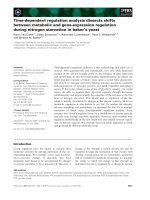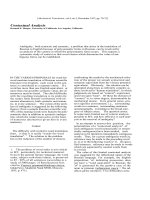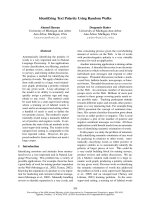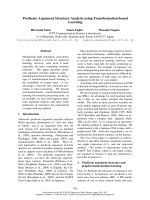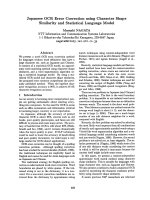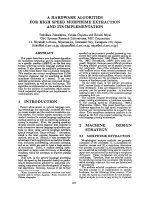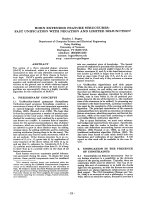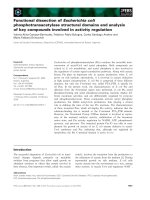Báo cáo khoa học: "Contextual Phrase-Level Polarity Analysis using Lexical Affect Scoring and Syntactic N-grams" ppt
Bạn đang xem bản rút gọn của tài liệu. Xem và tải ngay bản đầy đủ của tài liệu tại đây (254.61 KB, 9 trang )
Proceedings of the 12th Conference of the European Chapter of the ACL, pages 24–32,
Athens, Greece, 30 March – 3 April 2009.
c
2009 Association for Computational Linguistics
Contextual Phrase-Level Polarity Analysis using Lexical Affect Scoring
and Syntactic N-grams
Apoorv Agarwal
Department of Computer Science
Columbia University
New York, USA
Fadi Biadsy
Department of Computer Science
Columbia University
New York, USA
Kathleen R. Mckeown
Department of Computer Science
Columbia University
New York, USA
Abstract
We present a classifier to predict con-
textual polarity of subjective phrases in
a sentence. Our approach features lexi-
cal scoring derived from the Dictionary of
Affect in Language (DAL) and extended
through WordNet, allowing us to automat-
ically score the vast majority of words in
our input avoiding the need for manual la-
beling. We augment lexical scoring with
n-gram analysis to capture the effect of
context. We combine DAL scores with
syntactic constituents and then extract n-
grams of constituents from all sentences.
We also use the polarity of all syntactic
constituents within the sentence as fea-
tures. Our results show significant im-
provement over a majority class baseline
as well as a more difficult baseline consist-
ing of lexical n-grams.
1 Introduction
Sentiment analysis is a much-researched area that
deals with identification of positive, negative and
neutral opinions in text. The task has evolved from
document level analysis to sentence and phrasal
level analysis. Whereas the former is suitable for
classifying news (e.g., editorials vs. reports) into
positive and negative, the latter is essential for
question-answering and recommendation systems.
A recommendation system, for example, must be
able to recommend restaurants (or movies, books,
etc.) based on a variety of features such as food,
service or ambience. Any single review sentence
may contain both positive and negative opinions,
evaluating different features of a restaurant. Con-
sider the following sentence (1) where the writer
expresses opposing sentiments towards food and
service of a restaurant. In tasks such as this, there-
fore, it is important that sentiment analysis be done
at the phrase level.
(1) The Taj has great food but I found their ser-
vice to be lacking.
Subjective phrases in a sentence are carriers of
sentiments in which an experiencer expresses an
attitude, often towards a target. These subjective
phrases may express neutral or polar attitudes de-
pending on the context of the sentence in which
they appear. Context is mainly determined by con-
tent and structure of the sentence. For example, in
the following sentence (2), the underlined subjec-
tive phrase seems to be negative, but in the larger
context of the sentence, it is positive.
1
(2) The robber entered the store but his efforts
were crushed when the police arrived on time.
Our task is to predict contextual polarity of sub-
jective phrases in a sentence. A traditional ap-
proach to this problem is to use a prior polarity
lexicon of words to first set priors on target phrases
and then make use of the syntactic and semantic
information in and around the sentence to make
the final prediction. As in earlier approaches, we
also use a lexicon to set priors, but we explore
new uses of a Dictionary of Affect in Language
(DAL) (Whissel, 1989) extended using WordNet
(Fellbaum, 1998). We augment this approach with
n-gram analysis to capture the effect of context.
We present a system for classification of neutral
versus positive versus negative and positive versus
negative polarity (as is also done by (Wilson et al.,
2005)). Our approach is novel in the use of fol-
lowing features:
• Lexical scores derived from DAL and ex-
tended through WordNet: The Dictionary
of Affect has been widely used to aid in in-
terpretation of emotion in speech (Hirschberg
1
We assign polarity to phrases based on Wiebe (Wiebe et
al., 2005); the polarity of all examples shown here is drawn
from annnotations in the MPQA corpus. Clearly the assign-
ment of polarity chosen in this corpus depends on general
cultural norms.
24
et al., 2005). It contains numeric scores as-
signed along axes of pleasantness, activeness
and concreteness. We introduce a method for
setting numerical priors on words using these
three axes, which we refer to as a “scoring
scheme” throughout the paper. This scheme
has high coverage of the phrases for classi-
fication and requires no manual intervention
when tagging words with prior polarities.
• N-gram Analysis: exploiting automatically
derived polarity of syntactic constituents
We compute polarity for each syntactic con-
stituent in the input phrase using lexical af-
fect scores for its words and extract n-grams
over these constituents. N-grams of syntactic
constituents tagged with polarity provide pat-
terns that improve prediction of polarity for
the subjective phrase.
• Polarity of Surrounding Constituents: We
use the computed polarity of syntactic con-
stituents surrounding the phrase we want to
classify. These features help to capture the
effect of context on the polarity of the sub-
jective phrase.
We show that classification of subjective
phrases using our approach yields better accuracy
than two baselines, a majority class baseline and a
more difficult baseline of lexical n-gram features.
We also provide an analysis of how the differ-
ent component DAL scores contribute to our re-
sults through the introduction of a “norm” that
combines the component scores, separating polar
words that are less subjective (e.g., Christmas ,
murder) from neutral words that are more subjec-
tive (e.g., most, lack).
Section 2 presents an overview of previous
work, focusing on phrasal level sentiment analy-
sis. Section 3 describes the corpus and the gold
standard we used for our experiments. In sec-
tion 4, we give a brief description of DAL, dis-
cussing its utility and previous uses for emotion
and for sentiment analysis. Section 5 presents, in
detail, our polarity classification framework. Here
we describe our scoring scheme and the features
we extract from sentences for classification tasks.
Experimental set-up and results are presented in
Section 6. We conclude with Section 7 where we
also look at future directions for this research.
2 Literature Survey
The task of sentiment analysis has evolved from
document level analysis (e.g., (Turney., 2002);
(Pang and Lee, 2004)) to sentence level analy-
sis (e.g., (Hu and Liu., 2004); (Kim and Hovy.,
2004); (Yu and Hatzivassiloglou, 2003)). These
researchers first set priors on words using a prior
polarity lexicon. When classifying sentiment at
the sentence level, other types of clues are also
used, including averaging of word polarities or
models for learning sentence sentiment.
Research on contextual phrasal level sentiment
analysis was pioneered by Nasukawa and Yi
(2003), who used manually developed patterns to
identify sentiment. Their approach had high preci-
sion, but low recall. Wilson et al., (2005) also ex-
plore contextual phrasal level sentiment analysis,
using a machine learning approach that is closer to
the one we present. Both of these researchers also
follow the traditional approach and first set priors
on words using a prior polarity lexicon. Wilson
et al. (2005) use a lexicon of over 8000 subjec-
tivity clues, gathered from three sources ((Riloff
and Wiebe, 2003); (Hatzivassiloglou and McKe-
own, 1997) and The General Inquirer
2
). Words
that were not tagged as positive or negative were
manually labeled. Yi et al. (2003) acquired words
from GI, DAL and WordNet. From DAL, only
words whose pleasantness score is one standard
deviation away from the mean were used. Na-
sukawa as well as other researchers (Kamps and
Marx, 2002)) also manually tag words with prior
polarities. All of these researchers use categorical
tags for prior lexical polarity; in contrast, we use
quantitative scores, making it possible to use them
in computation of scores for the full phrase.
While Wilson et al. (2005) aim at phrasal level
analysis, their system actually only gives “each
clue instance its own label” [p. 350]. Their gold
standard is also at the clue level and assigns a
value based on the clue’s appearance in different
expressions (e.g., if a clue appears in a mixture of
negative and neutral expressions, its class is neg-
ative). They note that they do not determine sub-
jective expression boundaries and for this reason,
they classify at the word level. This approach is
quite different from ours, as we compute the po-
larity of the full phrase. The average length of
the subjective phrases in the corpus was 2.7 words,
with a standard deviation of 2.3. Like Wilson et al.
2
inquirer
25
(2005) we do not attempt to determine the bound-
ary of subjective expressions; we use the labeled
boundaries in the corpus.
3 Corpus
We used the Multi-Perspective Question-
Answering (MPQA version 1.2) Opinion corpus
(Wiebe et al., 2005) for our experiments. We
extracted a total of 17,243 subjective phrases
annotated for contextual polarity from the corpus
of 535 documents (11,114 sentences). These
subjective phrases are either “direct subjective”
or “expressive subjective”. “Direct subjective”
expressions are explicit mentions of a private state
(Quirk et al., 1985) and are much easier to clas-
sify. ”Expressive subjective” phrases are indirect
or implicit mentions of private states and therefore
are harder to classify. Approximately one third of
the phrases we extracted were direct subjective
with non-neutral expressive intensity whereas the
rest of the phrases were expressive subjective. In
terms of polarity, there were 2779 positive, 6471
negative and 7993 neutral expressions. Our Gold
Standard is the manual annotation tag given to
phrases in the corpus.
4 DAL
DAL is an English language dictionary built to
measure emotional meaning of texts. The samples
employed to build the dictionary were gathered
from different sources such as interviews, adoles-
cents’ descriptions of their emotions and univer-
sity students’ essays. Thus, the 8742 word dictio-
nary is broad and avoids bias from any one par-
ticular source. Each word is given three kinds of
scores (pleasantness – also called evaluation, ee,
activeness, aa and imagery, ii) on a scale of 1 (low)
to 3 (high). Pleasantness is a measure of polarity.
For example, in Table 1, affection is given a pleas-
antness score of 2.77 which is closer to 3.0 and
is thus a highly positive word. Likewise, active-
ness is a measure of the activation or arousal level
of a word, which is apparent from the activeness
scores of slug and energetic in the table. The third
score, imagery, is a measure of the ease with which
a word forms a mental picture. For example, af-
fect cannot be imagined easily and therefore has a
score closer to 1, as opposed to flower which is a
very concrete and therefore has an imagery score
of 3.
A notable feature of the dictionary is that it has
different scores for various inflectional forms of a
word ( affect and affection) and thus, morphologi-
cal parsing, and the possibility of resulting errors,
is avoided. Moreover, Cowie et al., (2001) showed
that the three scores are uncorrelated; this implies
that each of the three scores provide complemen-
tary information.
Word ee aa ii
Affect 1.75 1.85 1.60
Affection 2.77 2.25 2.00
Slug 1.00 1.18 2.40
Energetic 2.25 3.00 3.00
Flower 2.75 1.07 3.00
Table 1: DAL scores for words
The dictionary has previously been used for de-
tecting deceptive speech (Hirschberg et al., 2005)
and recognizing emotion in speech (Athanaselis et
al., 2006).
5 The Polarity Classification Framework
In this section, we present our polarity classifi-
cation framework. The system takes a sentence
marked with a subjective phrase and identifies the
most likely contextual polarity of this phrase. We
use a logistic regression classifier, implemented
in Weka, to perform two types of classification:
Three way (positive, negative, vs. neutral) and
binary (positive vs. negative). The features we
use for classification can be broadly divided into
three categories: I. Prior polarity features com-
puted from DAL and augmented using WordNet
(Section 5.1). II. lexical features including POS
and word n-gram features (Section 5.3), and III.
the combination of DAL scores and syntactic fea-
tures to allow both n-gram analysis and polarity
features of neighbors (Section 5.4).
5.1 Scoring based on DAL and WordNet
DAL is used to assign three prior polarity scores
to each word in a sentence. If a word is found in
DAL, scores of pleasantness (ee), activeness (aa),
and imagery (ii) are assigned to it. Otherwise, a
list of the word’s synonyms and antonyms is cre-
ated using WordNet. This list is sequentially tra-
versed until a match is found in DAL or the list
ends, in which case no scores are assigned. For
example, astounded, a word absent in DAL, was
scored by using its synonym amazed. Similarly,
in-humane was scored using the reverse polarity of
26
its antonym humane, present in DAL. These scores
are Z-Normalized using the mean and standard de-
viation measures given in the dictionary’s manual
(Whissel, 1989). It should be noted that in our cur-
rent implementation all function words are given
zero scores since they typically do not demonstrate
any polarity. The next step is to boost these nor-
malized scores depending on how far they lie from
the mean. The reason for doing this is to be able
to differentiate between phrases like “fairly decent
advice” and “excellent advice”. Without boosting,
the pleasantness scores of both phrases are almost
the same. To boost the score, we multiply it by
the number of standard deviations it lies from the
mean.
After the assignment of scores to individual
words, we handle local negations in a sentence by
using a simple finite state machine with two states:
RETAIN and INVERT. In the INVERT state, the
sign of the pleasantness score of the current word
is inverted, while in the RETAIN state the sign of
the score stays the same. Initially, the first word in
a given sentence is fed to the RETAIN state. When
a negation (e.g., not, no, never, cannot, didn’t)
is encountered, the state changes to the INVERT
state. While in the INVERT state, if ‘but’ is en-
countered, it switches back to the RETAIN state.
In this machine we also take care of “not only”
which serves as an intensifier rather than nega-
tion (Wilson et al., 2005). To handle phrases like
“no better than evil” and “could not be clearer”,
we also switch states from INVERT to RETAIN
when a comparative degree adjective is found after
‘not’. For example, the words in phrase in Table
(2) are given positive pleasantness scores labeled
with positive prior polarity.
Phrase has no greater desire
POS VBZ DT JJR NN
(ee) 0 0 3.37 0.68
State RETAIN INVERT RETAIN RETAIN
Table 2: Example of scoring scheme using DAL
We observed that roughly 74% of the content
words in the corpus were directly found in DAL.
Synonyms of around 22% of the words in the cor-
pus were found to exist in DAL. Antonyms of
only 1% of the words in the corpus were found in
DAL. Our system failed to find prior semantic ori-
entations of roughly 3% of the total words in the
corpus. These were rarely occurring words like
apartheid, apocalyptic and ulterior. We assigned
zero scores for these words.
In our system, we assign three DAL scores, us-
ing the above scheme, for the subjective phrase
in a given sentence. The features are (1) µ
ee
, the
mean of the pleasantness scores of the words in the
phrase, (2) µ
aa
, the mean of the activeness scores
of the words in the phrase, and similarly (3) µ
ii
,
the mean of the imagery scores.
5.2 Norm
We gave each phrase another score, which we call
the norm, that is a combination of the three scores
from DAL. Cowie et al. (2001) suggest a mecha-
nism of mapping emotional states to a 2-D contin-
uous space using an Activation-Evaluation space
(AE) representation. This representation makes
use of the pleasantness and activeness scores from
DAL and divides the space into four quadrants:
“delightful”, “angry”, “serene”, and “depressed”.
Whissel (2008), observes that tragedies, which
are easily imaginable in general, have higher im-
agery scores than comedies. Drawing on these ap-
proaches and our intuition that neutral expressions
tend to be more subjective, we define the norm in
the following equation (1).
norm =
√
ee
2
+ aa
2
ii
(1)
Words of interest to us may fall into the follow-
ing four broad categories:
1. High AE score and high imagery: These
are words that are highly polar and less sub-
jective (e.g., angel and lively).
2. Low AE score and low imagery: These are
highly subjective neutral words (e.g., gener-
ally and ordinary).
3. High AE score and low imagery: These are
words that are both highly polar and subjec-
tive (e.g., succeed and good).
4. Low AE score and high imagery: These are
words that are neutral and easily imaginable
(e.g., car and door).
It is important to differentiate between these
categories of words, because highly subjective
words may change orientation depending on con-
text; less subjective words tend to retain their prior
orientation. For instance, in the example sentence
from Wilson et al.(2005)., the underlined phrase
27
seems negative, but in the context it is positive.
Since a subjective word like succeed depends on
“what” one succeeds in, it may change its polar-
ity accordingly. In contrast, less subjective words,
like angel, do not depend on the context in which
they are used; they evoke the same connotation as
their prior polarity.
(3) They haven’t succeeded and will never succeed
in breaking the will of this valiant people.
As another example, AE space scores of good-
ies and good turn out to be the same. What differ-
entiates one from the another is the imagery score,
which is higher for the former. Therefore, value of
the norm is lower for goodies than for good. Un-
surprisingly, this feature always appears in the top
10 features when the classification task contains
neutral expressions as one of the classes.
5.3 Lexical Features
We extract two types of lexical features, part of
speech (POS) tags and n-gram word features. We
count the number of occurrences of each POS in
the subjective phrase and represent each POS as
an integer in our feature vector.
3
For each subjec-
tive phrase, we also extract a subset of unigram,
bigrams, and trigrams of words (selected automat-
ically, see Section 6). We represent each n-gram
feature as a binary feature. These types of features
were used to approximate standard n-gram lan-
guage modeling (LM). In fact, we did experiment
with a standard trigram LM, but found that it did
not improve performance. In particular, we trained
two LMs, one on the polar subjective phrases and
another on the neutral subjective phrases. Given a
sentence, we computed two perplexities of the two
LMs on the subjective phrase in the sentence and
added them as features in our feature vectors. This
procedure provided us with significant improve-
ment over a chance baseline but did not outper-
form our current system. We speculate that this
was caused by the split of training data into two
parts, one for training the LMs and another for
training the classifier. The resulting small quantity
of training data may be the reason for bad perfor-
mance. Therefore, we decided to back off to only
binary n-gram features as part of our feature vec-
tor.
3
We use the Stanford Tagger to assign parts of speech tags
to sentences. (Toutanova and Manning, 2000)
5.4 Syntactic Features
In this section, we show how we can combine the
DAL scores with syntactic constituents. This pro-
cess involves two steps. First, we chunk each
sentence to its syntactic constituents (NP, VP,
PP, JJP, and Other) using a CRF Chunker.
4
If
the marked-up subjective phrase does not contain
complete chunks (i.e., it partially overlaps with
other chunks), we expand the subjective phrase to
include the chunks that it overlaps with. We term
this expanded phrase as the target phrase, see Fig-
ure 1.
Second, each chunk in a sentence is then as-
signed a 2-D AE space score as defined by Cowie
et al., (2001) by adding the individual AE space
scores of all the words in the chunk and then nor-
malizing it by the number of words. At this point,
we are only concerned with the polarity of the
chunk (i.e., whether it is positive or negative or
neutral) and imagery will not help in this task; the
AE space score is determined from pleasantness
and activeness alone. A threshold, determined
empirically by analyzing the distributions of posi-
tive (pos), negative (neg) and neutral (neu) expres-
sions, is used to define ranges for these classes of
expressions. This enables us to assign each chunk
a prior semantic polarity. Having the semantic ori-
entation (positive, negative, neutral) and phrasal
tags, the sentence is then converted to a sequence
of encodings [P hrasal − T ag]
polarity
. We mark
each phrase that we want to classify as a “target” to
differentiate it from the other chunks and attach its
encoding. As mentioned, if the target phrase par-
tially overlaps with chunks, it is simply expanded
to subsume the chunks. This encoding is illus-
trated in Figure 1.
After these two steps, we extract a set of fea-
tures that are used in classifying the target phrase.
These include n-grams of chunks from the all
sentences, minimum and maximum pleasantness
scores from the chunks in the target phrase itself,
and the syntactic categories that occur in the con-
text of the target phrase. In the remainder of this
section, we describe how these features are ex-
tracted.
We extract unigrams, bigrams and trigrams of
chunks from all the sentences. For example, we
may extract a bigram from Figure 1 of [V P ]
neu
followed by [P P ]
target
neg
. Similar to the lexical
4
Xuan-Hieu Phan, “CRFChunker: CRF English Phrase
Chunker”, 2006.
28
!""#
!"#
$%&'($
!"#$
%&'
!"#$
%&'
!""#
$%&
!"#$%&'()%*+, /%
!"#$%&''()'*+,+'-%.&$%,+-%.#-"%)'&'#,()$%*('/+,'&0('%12%-"+%#'-+3'&0('&4%,+/#&5%
! ! "
!"! #
Figure 1: Converting a sentence with a subjective phrase to a sequence of chunks with their types and polarities
n-grams, for the sentence containing the target
phrase, we add binary values in our feature vec-
tor such that the value is 1 if the sentence contains
that chunk n-gram.
We also include two features related to the tar-
get phrase. The target phrase often consists of
many chunks. To detect if a chunk of the target
phrase is highly polar, minimum and maximum
pleasantness scores over all the chunks in the tar-
get phrase are noted.
In addition, we add features which attempt to
capture contextual information using the prior se-
mantic polarity assigned to each chunk both within
the target phrase itself and within the context of the
target phrase. In cases where the target phrase is
in the beginning of the sentence or at the end, we
simply assign zero scores. Then we compute the
frequency of each syntactic type (i.e., NP, VP, PP,
JJP) and polarity (i.e., positive, negative, neutral)
to the left of the target, to the right of the target
and for the target. This additional set of contextual
features yields 36 features in total: three polari-
ties: {positive, negative, neutral} * three contexts:
{left, target, right} * four chunk syntactic types:
{NP, VP, PP, JJP}.
The full set of features captures different types
of information. N-grams look for certain patterns
that may be specific to either polar or neutral senti-
ments. Minimum and maximum scores capture in-
formation about the target phrase standalone. The
last set of features incorporate information about
the neighbors of the target phrase. We performed
feature selection on this full set of n-gram related
features and thus, a small subset of these n-gram
related features, selected automatically (see sec-
tion 6) were used in the experiments.
6 Experiments and Results
Subjective phrases from the MPQA corpus were
used in 10-fold cross-validation experiments. The
MPQA corpus includes gold standard tags for each
Feature Types Accuracy Pos.* Neg.* Neu.*
Chance baseline 33.33% - - -
N-gram baseline 59.05% 0.602 0.578 0.592
DAL scores only 59.66% 0.635 0.635 0.539
+ POS 60.55% 0.621 0.542 0.655
+ Chunks 64.72% 0.681 0.665 0.596
+ N-gram (all) 67.51% 0.703 0.688 0.632
All (unbalanced) 70.76% 0.582 0.716 0.739
Table 3: Results of 3 way classification (Positive, Negative,
and Neutral). In the unbalanced case, majority class baseline
is 46.3% (*F-Measure).
Feature Types Accuracy Pos.* Neg.*
Chance baseline 50% - -
N-gram baseline 73.21% 0.736 0.728
DAL scores only 77.02% 0.763 0.728
+ POS 79.02% 0.788 0.792
+ Chunks 80.72% 0.807 0.807
+ N-gram (all) 82.32% 0.802 0.823
All (unbalanced) 84.08% 0.716 0.889
Table 4: Positive vs. Negative classification results. Baseline
is the majority class. In the unbalanced case, majority class
baseline is 69.74%. (* F-Measure)
phrase. A logistic classifier was used for two po-
larity classification tasks, positive versus negative
versus neutral and positive versus negative. We
report accuracy, and F-measure for both balanced
and unbalanced data.
6.1 Positive versus Negative versus Neutral
Table 3 shows results for a 3-way classifier. For
the balanced data-set, each class has 2799 in-
stances and hence the chance baseline is 33%. For
the unbalanced data-set, there are 2799 instances
of positive, 6471 instances of negative and 7993
instances of neutral phrases and thus the baseline
is about 46%. Results show that the accuracy in-
creases as more features are added. It may be
seen from the table that prior polarity scores do
not do well alone, but when used in conjunction
with other features they play an important role
in achieving an accuracy much higher than both
baselines (chance and lexical n-grams). To re-
29
Figure 2: (a) An example sentence with three annotated subjective phrases in the same sentence. (b) Part of the sentence with
the target phrase (B) and their chunks with prior polarities.
confirm if prior polarity scores add value, we ex-
perimented by using all features except the prior
polarity scores and noticed a drop in accuracy by
about 4%. This was found to be true for the
other classification task as well. The table shows
that parts of speech and lexical n-grams are good
features. A significant improvement in accuracy
(over 4%, p-value = 4.2e-15) is observed when
chunk features (i.e., n-grams of constituents and
polarity of neighboring constituents) are used in
conjunction with prior polarity scores and part of
speech features.
5
This improvement may be ex-
plained by the following observation. The bi-
gram “[Other]
target
neu
[NP ]
neu
” was selected as a
top feature by the Chi-square feature selector. So
were unigrams, [Other]
target
neu
and [Other]
target
neg
.
We thus learned n-gram patterns that are char-
acteristic of neutral expressions (the just men-
tioned bigram and the first of the unigrams) as
well as a pattern found mostly in negative ex-
pressions (the latter unigram). It was surpris-
ing to find another top chunk feature, the bigram
“[Other]
target
neu
[NP ]
neg
” (i.e., a neutral chunk of
syntactic type “Other” preceding a negative noun
phrase), present in neutral expressions six times
more than in polar expressions. An instance where
these chunk features could have been responsi-
ble for the correct prediction of a target phrase is
shown in Figure 2. Figure 2(a) shows an exam-
ple sentence from the MPQA corpus, which has
three annotated subjective phrases. The manually
labeled polarity of phrases (A) and (C) is negative
and that of (B) is neutral. Figure 2(b) shows the
5
We use the binomial test procedure to test statistical sig-
nificance throughout the paper.
relevant chunk bigram which is used to predict the
contextual polarity of the target phrase (B).
It was interesting to see that the top 10 features
consisted of all categories (i.e., prior DAL scores,
lexical n-grams and POS, and syntactic) of fea-
tures. In this and the other experiment, pleasant-
ness, activation and the norm were among the top
5 features. We ran a significance test to show the
importance of the norm feature in our classifica-
tion task and observed that it exerted a significant
increase in accuracy (2.26%, p-value = 1.45e-5).
6.2 Positive versus Negative
Table 4 shows results for positive versus negative
classification. We show results for both balanced
and unbalanced data-sets. For balanced, there are
2779 instances of each class. For the unbalanced
data-set, there are 2779 instances of positive and
6471 instances of neutral, thus our chance base-
line is around 70%. As in the earlier classification,
accuracy and F-measure increase as we add fea-
tures. While the increase of adding the chunk fea-
tures, for example, is not as great as in the previous
classification, it is nonetheless significant (p-value
= 0.0018) in this classification task. The smaller
increase lends support to our hypothesis that po-
lar expressions tend to be less subjective and thus
are less likely to be affected by contextual polar-
ity. Another thing that supports our hypothesis that
neutral expressions are more subjective is the fact
that the rank of imagery (ii), dropped significantly
in this classification task as compared to the previ-
ous classification task. This implies that imagery
has a much lesser role to play when we are dealing
with non-neutral expressions.
30
7 Conclusion and Future Work
We present new features (DAL scores, norm
scores computed using DAL, n-gram over chunks
with polarity) for phrasal level sentiment analysis.
They work well and help in achieving high accu-
racy in a three-way classification of positive, neg-
ative and neutral expressions. We do not require
any manual intervention during feature selection,
and thus our system is fully automated. We also
introduced a 3-D representation that maps differ-
ent classes to spatial coordinates.
It may seem to be a limitation of our system that
it requires accurate expression boundaries. How-
ever, this is not true for the following two reasons:
first, Wiebe et al., (2005) declare that while mark-
ing the span of subjective expressions and hand
annotating the MPQA corpus, the annotators were
not trained to mark accurate expression bound-
aries. The only constraint was that the subjective
expression should be within the mark-ups for all
annotators. Second, we expanded the marked sub-
jective phrase to subsume neighboring phrases at
the time of chunking.
A limitation of our scoring scheme is that it
does not handle polysemy, since words in DAL
are not provided with their parts of speech. Statis-
tics show, however, that most words occurred with
primarily one part of speech only. For example,
“will” occurred as modal 1272 times in the corpus,
whereas it appeared 34 times as a noun. The case
is similar for “like” and “just”, which mostly occur
as a preposition and an adverb, respectively. Also,
in our state machine, we haven’t accounted for the
impact of connectives such as “but” or “although”;
we propose drawing on work in argumentative ori-
entation to do so ((Anscombre and Ducrot, 1983);
(Elhadad and McKeown, 1990)).
For future work, it would be interesting to do
subjectivity and intensity classification using the
same scheme and features. Particularly, for the
task of subjectivity analysis, we speculate that the
imagery score might be useful for tagging chunks
with “subjective” and “objective” instead of posi-
tive, negative, and neutral.
Acknowledgments
This work was supported by the National Science
Foundation under the KDD program. Any opin-
ions, ndings, and conclusions or recommendations
expressed in this paper are those of the authors and
do not necessarily reect the views of the National
Science Foundation. score.
We would like to thank Julia Hirschberg for use-
ful discussion. We would also like to acknowledge
Narayanan Venkiteswaran for implementing parts
of the system and Amal El Masri, Ashleigh White
and Oliver Elliot for their useful comments.
References
J.C. Anscombre and O. Ducrot. 1983. Philosophie et
langage. l’argumentation clans la langue. Bruxelles:
Pierre Mardaga.
T. Athanaselis, S. Bakamidis, , and L. Dologlou. 2006.
Automatic recognition of emotionally coloured
speech. In Proceedings of World Academy of Sci-
ence, Engineering and Technology, volume 12, ISSN
1307-6884.
R. Cowie, E. Douglas-Cowie, N. Tsapatsoulis, G. Vot-
sis, S. Kollias, and W. Fellenz et al. 2001. Emo-
tion recognition in human-computer interaction. In
IEEE Signal Processing Magazine, 1, 32-80.
M. Elhadad and K. R. McKeown. 1990. Generating
connectives. In Proceedings of the 13th conference
on Computational linguistics, pages 97–101, Mor-
ristown, NJ, USA. Association for Computational
Linguistics.
C. Fellbaum. 1998. Wordnet, an electronic lexical
database. In MIT press.
V. Hatzivassiloglou and K. McKeown. 1997. Predict-
ing the semantic orientation of adjectives. In Pro-
ceedings of ACL.
J. Hirschberg, S. Benus, J.M. Brenier, F. Enos, and
S. Friedman. 2005. Distinguishing deceptive from
non-deceptive speech. In Proceedings of Inter-
speech, 1833-1836.
M. Hu and B. Liu. 2004. Mining and summarizing
customer reviews. In Proceedings of KDD.
J. Kamps and M. Marx. 2002. Words with attitude. In
1st International WordNet Conference.
S. M. Kim and E. Hovy. 2004. Determining the senti-
ment of opinions. In In Coling.
T. Nasukawa and J. Yi. 2003. Sentiment analysis:
Capturing favorability using natural language pro-
cessing. In Proceedings of K-CAP.
B. Pang and L. Lee. 2004. A sentimental education:
Sentiment analysis using subjectivity analysis using
subjectivity summarization based on minimum cuts.
In Proceedings of ACL.
R. Quirk, S. Greenbaum, G. Leech, and J. Svartvik.
1985. A comprehensive grammar of the english lan-
guage. Longman, New York.
31
E. Riloff and J. Wiebe. 2003. Learning extraction pat-
terns for subjective expressions. In Proceedings of
EMNLP.
K. Toutanova and C. D. Manning. 2000. Enriching
the knowledge sources used in a maximum entropy
part-of-speech tagger. In Proceedings of the Joint
SIGDAT Conference on Empirical Methods in Nat-
ural Language Processing and Very Large Corpora
(EMNLP/VLC-2000), pp. 63-70.
P. Turney. 2002. Thumbs up or thumbs down? seman-
tic orientation applied to unsupervised classification
of reviews. In Proceedings of ACL.
C. M. Whissel. 1989. The dictionary of affect in lan-
guage. In R. Plutchik and H. Kellerman, editors,
Emotion: theory research and experience, volume 4,
Acad. Press., London.
C. M. Whissell. 2008. A psychological investiga-
tion of the use of shakespeare=s emotional language:
The case of his roman tragedies. In Edwin Mellen
Press., Lewiston, NY.
J. Wiebe, T. Wilson, and C. Cardie. 2005. Annotating
expressions of opinions and emotions in language.
In Language Resources and Evaluation, volume 39,
issue 2-3, pp. 165-210.
T. Wilson, J. Wiebe, and P. Hoffman. 2005. Recog-
nizing contextual polarity in phrase level sentiment
analysis. In Proceedings of ACL.
J. Yi, T. Nasukawa, R. Bunescu, and W. Niblack. 2003.
Sentiment analyzer: Extracting sentiments about a
given topic using natural language processing tech-
niques. In Proceedings of IEEE ICDM.
H. Yu and V. Hatzivassiloglou. 2003. Towards an-
swering opinion questions: Separating facts from
opinions and identifying the polarity of opinion sen-
tences. In Proceedings of EMNLP.
32
